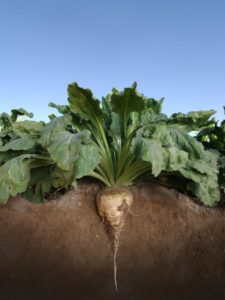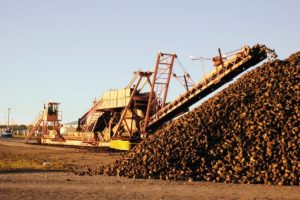As Tom and I traveled from Washington to Ohio, we saw many signs for the Oregon Trail. We also saw sugar beets in so many different forms that we ended up learning a lot about sugar beets.
 Before this particular sojourn out west, I had never thought about sugar beets at all. I like pickled beets and have, reluctantly, eaten stewed beets. I even tried Borscht – once. But the beets that we saw out west were nothing like the beets that grow in gardens in Ohio.
Before this particular sojourn out west, I had never thought about sugar beets at all. I like pickled beets and have, reluctantly, eaten stewed beets. I even tried Borscht – once. But the beets that we saw out west were nothing like the beets that grow in gardens in Ohio.
 When we first saw the semi-trucks loaded with sugar beets, we thought they were loaded with rocks. The beets were covered with dirt and looked like softballs. We couldn’t figure out why so many trucks were moving rocks from one place to another. We saw giant piles of these rocks dumped on asphalt. Then we saw the harvesters in the fields and realized it was some crop. From there we learned that the crop was sugar beets.
When we first saw the semi-trucks loaded with sugar beets, we thought they were loaded with rocks. The beets were covered with dirt and looked like softballs. We couldn’t figure out why so many trucks were moving rocks from one place to another. We saw giant piles of these rocks dumped on asphalt. Then we saw the harvesters in the fields and realized it was some crop. From there we learned that the crop was sugar beets.
When we think of sugar, we imagine it all comes from sugar cane. But sugar beets produce over 20% of the world’s sugar. 55% of the sugar production in the United States is from beets grown in 11 states. 45% of the sugar in the U.S. is from cane grown in four states. U.S. farmers grow over a million acres of sugar beets every year. Although Domino Sugar is made from sugar cane, Crystal Sugar, Western Sugar, Pioneer Sugar, and Spreckels Sugar are all made from sugar beets. Next time you go to the grocery store, see if you can find some sugar made from beets.
 Sugar beets are a huge industry in the west. The industry creates 142,000 jobs. The beets are planted in April or May and then harvested in September or October. Sugar beet factories run 24/7 from October through April. Here is a good, short video on sugar production. Many retirees who are full-time RVers have worked the sugar harvest or worked in a beet factory. All parts of the sugar beet are used. The green tops are cut off in the fields and, after harvest, cattle roam the fields eating the foliage. The pulp left after the sugar is extracted at the factories is dried for cattle feed. It is also used on icy roads in Wyoming and Nebraska in the winter.
Sugar beets are a huge industry in the west. The industry creates 142,000 jobs. The beets are planted in April or May and then harvested in September or October. Sugar beet factories run 24/7 from October through April. Here is a good, short video on sugar production. Many retirees who are full-time RVers have worked the sugar harvest or worked in a beet factory. All parts of the sugar beet are used. The green tops are cut off in the fields and, after harvest, cattle roam the fields eating the foliage. The pulp left after the sugar is extracted at the factories is dried for cattle feed. It is also used on icy roads in Wyoming and Nebraska in the winter.
Tom and I found sugar beets surprisingly fascinating. Who knew that the ugly, dirty rock-like beets taken out of the fields could become wonderful white sugar?

Loved this interesting history on sugar beets..a good lesson!
Thanks. It is amazing what you learn as you travel!